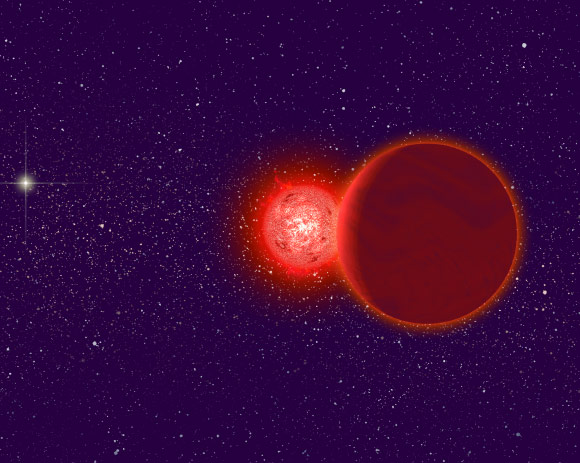February 18, 2015 – Some 70,000 years ago a binary star system is believed to have passed within 0.8 light years of our Sun. That’s less than one-fifth the distance of our nearest stellar neighbour, Proxima Centauri.
Discovered by Ralf-Dieter Scholz of the Leibniz-Institut für Astrophysik Potsdam, Germany, in 2014, and reported in the journal, Astrophysics, this flyby was actually a member of a binary system containing a red and brown dwarf. The binary system was given the name Scholz’s Star in honour of its discoverer.
Red dwarfs are the most common stars found in our Milky Way galaxy. Proxima Centauri our current closest neighbour at just over 4 light years is a red dwarf. In fact two-thirds of the stars in the Sun’s neighbourhood are red dwarfs. There are also many brown dwarfs. The latter are sub-stellar masses that may never have attained sufficient size to ignite. They are, as a result, very hard to detect.
We only recently discovered Scholz’s Star. There are many reasons why it escaped our notice. One is the size of the binary star system, a mere 14% of the Sun’s mass combined. Another is the amount of light emitted by the binary system. Even at its closest point to the Solar System, 52,000 astronomical units (AUs), it would appear as a magnitude 10 star.
To give you a frame of reference, typically when we look into the night sky we see stars of various magnitudes from 1 to 6. Sirius, the brightest in the night sky other than the Moon, Jupiter and Venus, is a magnitude 1.6 star. We see it very clearly. But other stars appear faint and when the magnitude is beyond 6 we can only discern them through a telescope. So at magnitude 10 Scholz’s Star would have been invisible to our ancestors 70,000 years ago.
Did Scholz’s Star pass through our Solar System’s Oort Cloud with the estimated outer boundary at 100,000 AUs? Most certainly. Could we eventually see the results of that encounter in the years to come? We may at some point witness the birth of a long period comet that was first stirred from its orbit in the Oort Cloud by the passing of Scholz’s Star. But more than likely not.
Have there been past close encounters with other stars? Some scientists have tried to equate cycles of extinction here on Earth with the existence of a binary companion to the Sun. In 1984 astronomer Richard Muller hypothesized the existence of a red dwarf star orbiting the Sun some 1.5 light years away. Muller called it Nemesis and calculated its orbit lasting 27 million years, correlating with extinction cycles going back hundreds of millions of years.
Others have speculated on the existence of a brown dwarf on the outer edge of the Oort Cloud, or a number of gas giant planets too dim for us to see but part of our Solar System and still to be discovered.
Will another star pass by in the near future. If you stick around for a couple of hundred thousand years, scientists have a candidate that goes by the name HIP-85605.
What would Scholz’s star’s close encounter looked like to our Sun 70,000 years ago? The picture below, rendered by Michael Osadciw of University of Rochester, provides us with a sense of that close encounter. The Sun appears in the background to the left of the binary system, a brilliant point of light, still too far away to see its burning globular mass.










